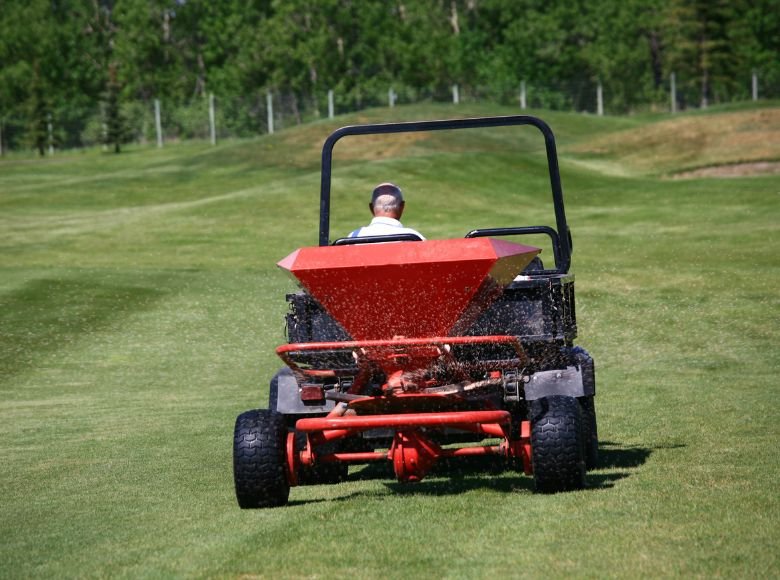Winter golf course maintenance is vital for Florida’s mild winters, and fertilization plays a crucial role by providing essential nutrients, strengthening roots against cold conditions, guarding against diseases, keeping the course aesthetically pleasing, and employing a careful, environmentally friendly fertilization approach with the right slow-release fertilizers—DTE Golf ® ensures your golf course remains healthy and visually appealing throughout the winter.
As winter arrives in Florida, golf courses need special care to keep the grass healthy. Fertilization becomes crucial during this time to make sure the golf course looks great when spring arrives. Let’s explore why using fertilizer is so important for maintaining a fantastic golfing experience during the winter.
Feeding the Grass with Essential Nutrients
Even in Florida’s mild winter, the grass on golf courses needs some extra care. Fertilization is like treating the grass to a special meal that gives it the nutrients it craves. Nutrients such as nitrogen, phosphorus, and potassium are like superfoods for the grass. Using the right fertilizer ensures that these essential nutrients are available, helping the grass grow strong roots and maintaining its overall health. It’s like providing the grass with the perfect nutrition to keep it vibrant and thriving, even during the winter season.
Making Roots Stronger and Ready for the Cold

Winter can be a bit challenging for the grass, even in Florida. To help the grass face the cold weather, especially at its roots, fertilization becomes a superhero. Using fertilizers rich in phosphorus is like giving the roots a power boost. These stronger roots not only anchor the grass securely but also equip it to handle shifts in temperature and other winter challenges. This fortification against the cold ensures that the grass remains healthy and resilient throughout the winter season, making it ready to bounce back when the warmer days return.
Guarding Against Diseases
Winter weather can create conditions that make it easier for diseases to attack the grass on golf courses. Fertilization, with the right nutrients, acts like a shield for the grass, helping it build its own defense system. This defense system makes the grass more resistant to common diseases that might pop up during winter.
When the grass is well-fed, it can effectively fight off diseases, ensuring that the golf course stays healthy and maintains its pristine appearance. It’s like providing the grass with the tools it needs to stay strong and disease-free, contributing to the overall well-being of the golf course.
Keeping the Golf Course Looking Good
Even though the grass might not be as vibrant during winter, maintaining a visually pleasing golf course is essential. The right fertilization plays a crucial role in supporting the grass to retain its color and density. This ensures that the golf course remains aesthetically pleasing, even in the winter months.
A well-kept course contributes to the overall golfing experience, creating a positive impression for players. It helps uphold the reputation of the golf course as a top-notch facility, showcasing a commitment to excellence in both appearance and playability throughout the year.
Balancing with the Environment in Mind
When it comes to winter fertilization, it’s important to be mindful of the environment. Applying fertilizer needs careful consideration, ensuring not to use too much and potentially harm the surroundings. Responsible fertilization takes into account what the grass specifically needs, the type of soil present, and the nearby environment.
By approaching fertilization with care, golf course managers play a crucial role in protecting the environment, minimizing any negative impact on nearby ecosystems, and simultaneously keeping the grass in good health. It’s like finding the right balance where the grass gets what it needs, and the environment stays unharmed.
Using the Right Fertilization Approach
Winter requires a different game plan for fertilization, and slow-release fertilizers emerge as the preferred choice. These fertilizers provide the grass with a steady and gradual supply of nutrients over an extended period. This aligns well with the slower growth pace of the grass during winter, ensuring it can efficiently absorb the nutrients without experiencing excessive growth.
It’s akin to giving the grass a measured and consistent diet that suits its winter rhythm, resulting in a healthier and well-nourished turf without unnecessary stress. This approach to fertilization in winter is a smart strategy for promoting grass health while being considerate of its natural growth patterns.
In the world of winter golf course care in Florida, fertilization stands out as a crucial part of keeping the grass healthy, resilient, and looking good. A well-planned fertilization routine addresses the unique challenges of winter, making sure golf courses stay in great shape for golfers to enjoy. Recognizing the importance of fertilization in winter helps golf course managers create a thriving and beautiful landscape, setting the stage for a lively spring and a successful golf season.
Contact DTE Golf® today for professional and top-notch golf course management services. Let’s create an exceptional golfing atmosphere together!
